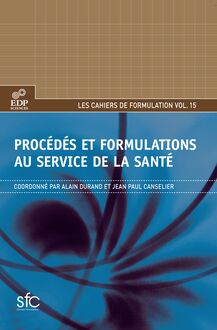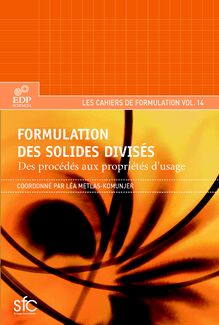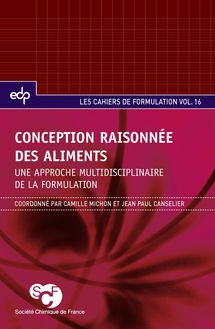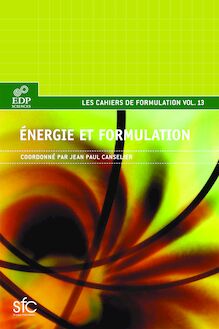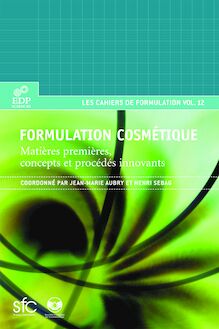-
 Univers
Univers
-
 Ebooks
Ebooks
-
 Livres audio
Livres audio
-
 Presse
Presse
-
 Podcasts
Podcasts
-
 BD
BD
-
 Documents
Documents
-
- Cours
- Révisions
- Ressources pédagogiques
- Sciences de l’éducation
- Manuels scolaires
- Langues
- Travaux de classe
- Annales de BEP
- Etudes supérieures
- Maternelle et primaire
- Fiches de lecture
- Orientation scolaire
- Méthodologie
- Corrigés de devoir
- Annales d’examens et concours
- Annales du bac
- Annales du brevet
- Rapports de stage
La lecture à portée de main
Découvre YouScribe en t'inscrivant gratuitement
Je m'inscrisConception raisonnée des aliments , livre ebook
Découvre YouScribe en t'inscrivant gratuitement
Je m'inscrisEn savoir plus
En savoir plus

Description
Ce 16e volume des Cahiers de Formulation rassemble douze des interventions effectuées lors des 14es Journées de Formulation, organisées à Paris par la Société Chimique de France.
Dans le présent volume, les avancées et spécificités de la conception raisonnée des produits dans le domaine alimentaire sont présentées tout en s’attachant à montrer les transferts possibles de ces approches vers les autres secteurs (chimie, cosmétique…). Au début de l’ouvrage, le lecteur est résolument placé dans une logique de formulation très spécifique aux aliments, avec la présentation des outils de la gastronomie moléculaire, leurs atouts en innovation et le lien possible avec les approches culinaires. Les sept chapitres de la première partie abordent les enjeux et les méthodologies possibles pour une démarche de formulation. Elle s’insère complètement dans le cycle de vie d’un aliment et tient compte de la diversité des consommateurs et de leurs attentes en termes de prix, d’apport nutritionnel, de plaisir, d’usage… La deuxième partie de ce volume s’attache, à travers des exemples d’études menées en lien avec des applications, à illustrer la force des approches multi-échelles intégrant les aspects produit/procédé.
Sujets
Informations
| Publié par | EDP Sciences |
| Date de parution | 01 avril 2013 |
| Nombre de lectures | 1 |
| EAN13 | 9782759810352 |
| Langue | Français |
| Poids de l'ouvrage | 8 Mo |
Informations légales : prix de location à la page 0,5250€. Cette information est donnée uniquement à titre indicatif conformément à la législation en vigueur.
Extrait
-
 Univers
Univers
-
 Ebooks
Ebooks
-
 Livres audio
Livres audio
-
 Presse
Presse
-
 Podcasts
Podcasts
-
 BD
BD
-
 Documents
Documents
-
Jeunesse
-
Littérature
-
Ressources professionnelles
-
Santé et bien-être
-
Savoirs
-
Education
-
Loisirs et hobbies
-
Art, musique et cinéma
-
Actualité et débat de société
-
Jeunesse
-
Littérature
-
Ressources professionnelles
-
Santé et bien-être
-
Savoirs
-
Education
-
Loisirs et hobbies
-
Art, musique et cinéma
-
Actualité et débat de société
-
Actualités
-
Lifestyle
-
Presse jeunesse
-
Presse professionnelle
-
Pratique
-
Presse sportive
-
Presse internationale
-
Culture & Médias
-
Action et Aventures
-
Science-fiction et Fantasy
-
Société
-
Jeunesse
-
Littérature
-
Ressources professionnelles
-
Santé et bien-être
-
Savoirs
-
Education
-
Loisirs et hobbies
-
Art, musique et cinéma
-
Actualité et débat de société
- Cours
- Révisions
- Ressources pédagogiques
- Sciences de l’éducation
- Manuels scolaires
- Langues
- Travaux de classe
- Annales de BEP
- Etudes supérieures
- Maternelle et primaire
- Fiches de lecture
- Orientation scolaire
- Méthodologie
- Corrigés de devoir
- Annales d’examens et concours
- Annales du bac
- Annales du brevet
- Rapports de stage
